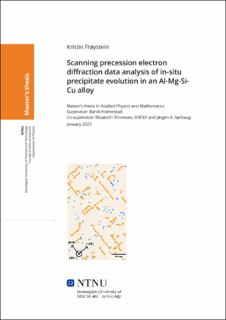| dc.contributor.advisor | Holmestad, Randi | |
| dc.contributor.advisor | Thronsen, Elisabeth | |
| dc.contributor.advisor | Sørhaug, Jørgen A. | |
| dc.contributor.author | Frøystein, Kristin | |
| dc.date.accessioned | 2023-05-04T17:19:51Z | |
| dc.date.available | 2023-05-04T17:19:51Z | |
| dc.date.issued | 2023 | |
| dc.identifier | no.ntnu:inspera:136977053:36858915 | |
| dc.identifier.uri | https://hdl.handle.net/11250/3066308 | |
| dc.description.abstract | Materialet studert in denne masteroppgaven er en Al-Mg-Si-Cu (6xxx) aluminiumlegering.
Precipitatene som dannes i denne legeringen under utherding bestemmer
mange av materialets mekansike egenskaper, inkludert styrke. Å forstå hvordan forskjellige
temperaturer påvirker sammensetningen av og krystallstrukturen til presipitatene
er derfor viktig, for å forstå hvordan varmebehandling av materialet påvirker
dets fysiske egenskaper.
En metode for å undersøke krystallstrukturen til materialer er ved skannende presesjonselektrondiffraksjon.
Skannende presesjonselektrondiffraksjon er en transmisjonselektronmikroskopiteknikk
som gir dataset av høy kvalitet. Et dataset can inneholde
hundretusener av diffraksjonsmøntre, og hvert dataset kan være på størreslse
med noen gigabyte. Disse store mengdene data kan være krevende å analysere
manuelt. Derfor er maskinlæring en naturlig tilnærming for å utvinne informasjon
fra disse datasettene.
I denne masteroppgaven er skannende presesjonselektrondiffraksjon-datasett fra en
Al-Mg-Si-Cu (6xxx) aluminiumlegerering studert. Datasettene ble tatt opp samtidig
som prøven ble in-situ oppvarmet med en konstant oppvarmingsrate på 0.01 K/s.
Dataanalysemetodene brukt i masteroppgaven er hovedkomponentanalyse og ikkenegativ
matrisefaktorisering. Den ikke-negative matrisefaktoriseringen avlørte at
det er 4 faser tilstede i datasettene. Disse er β′′, L, C og Q′. Fra den ikke-negative
matrisefaktoriseringen har det blitt laget fasekart ved å bruke en kombinasjon av
maskering, kurvetilpassning av Gaussiske funksjoner og grenseverdier.
Målene med masteroppgaven var å undersøke hvordan presipitatene utvikler seg ved
varmebehandling, og å finne ut hvilke faser som eksisterer ved hvilke temperaturer.
En udersøkelse av fasetransformasjonene som skjer er også gjort, for å finne ut
om transformasjonene skjer ved oppløsning og nukleering, eller ved kontinuerlige
transformasjoner. Mulige fasetransformasjoner som ble observert var β′′ til L, β′′ til
C, og L til Q′. | |
| dc.description.abstract | The material studied in this thesis is a Al-Mg-Si-Cu (6xxx) aluminium alloy. The
precipitates that form in this alloy during ageing determines many of the material’s
mechanical properties, including strength. Understanding how different temperatures
influence the composition and crystal structure of precipitates is therefore
important to understand how heat treatment affects the materials physical properties.
A method of investigating the crystal structure of materials is scanning precession
electron diffraction. Scanning precession electron diffraction is a transmission electron
microscopy technique that yields datasets of high quality. One dataset can
contain hundreds of thousands of diffraction patterns, and each can be be few gigabytes
in size. These large quantities of data can be tedious to analyse manually.
Therefore, machine learning is a natural approach to extract information from these
datasets.
In this master’s thesis, scanning precession electron diffraction datasets from an
Al-Mg-Si-Cu (6xxx) aluminium alloy sample have been studied. The datasets were
recorded as the sample was in-situ heated, with a constant heating rate of 0.01 K/s.
The data analysis used in the thesis are principal components analysis using singular
value decomposition and non-negative matrix factorisation. The non-negative matrix
factorisation revealed that there are 4 phases present in the datasets. These are
β′′, L, C and Q′. From the non-negative matrix factorisation, phase maps were created
using a combination of masking, the fitting of Gaussian functions and threshold
values.
The main goals of the master thesis are to examine how the precipitates evolve
during the heat treatment, and find which phases exist at what temperatures. An
investigating into how the phase transformations are happening is also carried out.
Do the transformations occur through dissolution and nucleation or through continuous
phase transformations? Possible phase transitions were observed, and these
are β′′ to L, β′′ to C, and L to Q′. | |
| dc.language | eng | |
| dc.publisher | NTNU | |
| dc.title | Scanning precession electron diffraction data analysis of in-situ precipitate evolution in an Al-Mg-Si-Cu alloy | |
| dc.type | Master thesis | |
